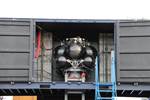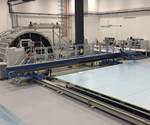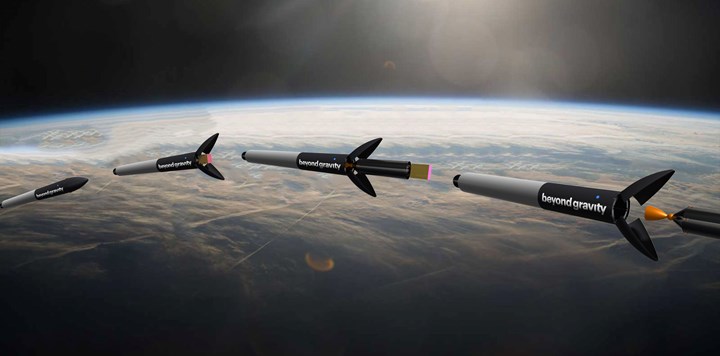Beyond Gravity innovates space with reusable payload fairing
Reuse of composite second stage half-shells could make rockets more accessible to various companies and support more frequent launches.
The second stage being released during a rocket launch, before first stage closes again and returns to Earth. Photo Credit: Beyond Gravity
International space supplier Beyond Gravity’s (formerly RUAG Space, Zürich, Switzerland) Launcher Innovation Team is innovating space launches with a payload fairing concept that allows the carbon fiber-reinforced polymer (CFRP) payload fairing to close again — after the payload and the second stage are released — and return to Earth together with the first stage of the launcher.
Instead of the half-shells being completely separated from the second stage, as is the case today, the two half-shells will open, release the payload and then close again while remaining attached to the first stage of the launcher. Unlike traditional fairings, the payload fairing will remain attached to the first stage throughout the entire flight and re-enter the atmosphere with it for a soft landing. This novel approach tackles reusability, schedule flexibility, and cost reduction of launch systems and payload fairings.
“This approach is set to address the evolving market’s needs while staying true to Beyond Gravity’s commitment to sustainability, innovation and dedication to a 100% mission success,” explains Paul Horstink, executive VP at Beyond Gravity’s Launcher Division. “In addition, the cost savings associated with reusable rockets could make the launch systems more
accessible to a wider range of companies and organizations, supporting more frequent launches.”
The concept is initially being developed with medium launch vehicles in mind, which with ongoing research refining the system architecture and subsystems, could be scaled up to large vehicles. “We envisions future collaborations with launcher primes to develop reusable launchers and the potential to introduce novel subsystem solutions beneficial for a range of products,” Horstink adds. “We are working closely together with our current customer base as well as new players in the commercial space market to develop this concept further.”
Beyond Gravity has four decades of experience in the production of payload fairings and has been a key contributor to the evolution of ArianeGroup and United Launch Alliance (ULA) launch vehicles (read “Beyond Gravity wins contract for Ariane 6 payload fairings”), particularly in the development of advanced lightweight structures.
Next to reusable payload fairings, Beyond Gravity is fostering partnerships in innovation and research by cooperating with startups and upcoming players in the international space ecosystem. The company’s own startup program, Launchpad, has successfully established collaborations with several of these startups. For instance, Beyond Gravity is working with RevoAI (Karlsruhe, Germany) on a European Space Agency (ESA) project to assess the use of artificial intelligence in the development of future structures. Another startup, Gate Space (San Francisco, Calif., U.S.), is developing a sustainable solution for satellite propulsion with refueling capability. Ethereal X (Bangalore, India), another startup in Beyond Gravity’s startup ecosystem, is working on a 100% reusable rocket.
Beyond Gravity has been recognized as one of the top 150 most innovative companies in Switzerland in the “Top Innovative Companies 2024” ranking.
For related content, read “RUAG rebrands as Beyond Gravity, boosts CFRP satellite dispenser capacity.”
Related Content
-
Infinite Composites: Type V tanks for space, hydrogen, automotive and more
After a decade of proving its linerless, weight-saving composite tanks with NASA and more than 30 aerospace companies, this CryoSphere pioneer is scaling for growth in commercial space and sustainable transportation on Earth.
-
Materials & Processes: Resin matrices for composites
The matrix binds the fiber reinforcement, gives the composite component its shape and determines its surface quality. A composite matrix may be a polymer, ceramic, metal or carbon. Here’s a guide to selection.
-
Materials & Processes: Fabrication methods
There are numerous methods for fabricating composite components. Selection of a method for a particular part, therefore, will depend on the materials, the part design and end-use or application. Here's a guide to selection.

















